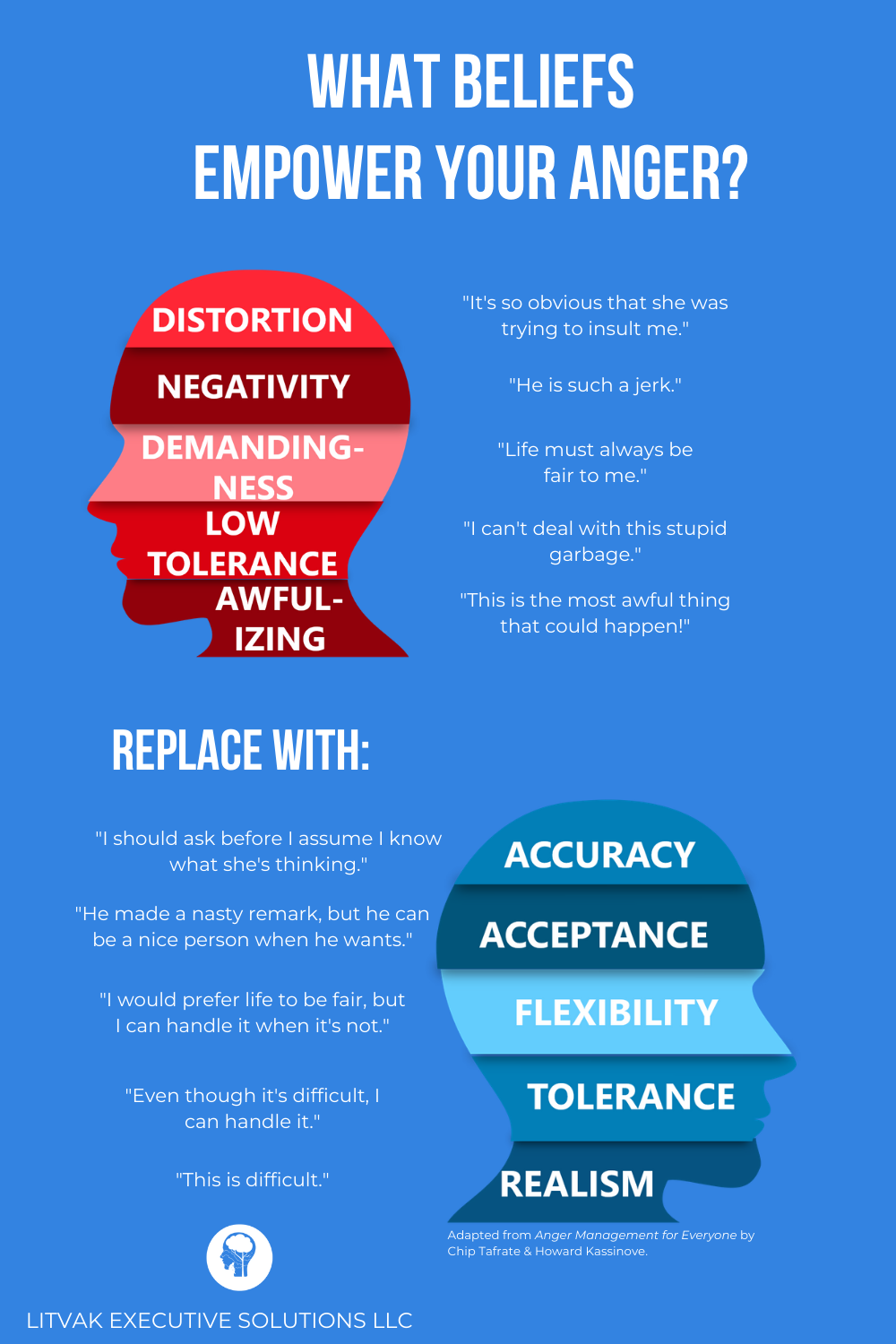Have you noticed that temperatures seem to be running high these days? The COVID-19 crisis has brought out the best in humanity (thank you, healthcare workers), but has also increased our feelings of anxiety. Fuses are short and conflict seems rife.
How can we best handle conflict during this time of unprecedented stress and strain? How can we diffuse feelings of anger before they reach the boiling point and we inflict real damage, physical or otherwise, on one another?
In the first part of this series on how to diffuse conflict during crisis, we will focus on managing our anger. Let's break it down into four basic steps:
- Be aware of your triggers.
- Know how to cool yourself down.
- Examine your beliefs and ask questions.
- Talk it out.
Step 1 of Managing Anger: Be aware of your triggers.
The first step in relating to anger is to become aware of when your emotions are building to a harmful point, and what triggered you to feel that way. Some common triggers for feelings of anger include:
- hurts (perceived or real)
- insults (real or perceived)
- frustrations (real or perceived)
- violation of rights (real or perceived)
- needs (real or perceived) going unmet
Accept your feelings. They are part of you. But be aware of when they are building to a harmful point.
When your thoughts of a person or situation become obsessive and you’re repeating the same thought over and over, you’re likely at that point already. Other signs may be that you find it hard to sit still, or others tell you that you aren’t thinking rationally about the situation, and so on. Learn to recognize your own signs of emotional buildup.
Step 2 of Managing your Anger: Know how to cool yourself down.
Learn how to self-soothe your anger with relaxation techniques. This helps calm your body and mind and will help you respond less impulsively.
Here are some tried and true techniques suggested by clinical psychologists Chip Tafrate and Howard Kassinove in their excellent book, Anger Management for Everyone: Ten Proven Strategies to Help you Control Anger and Live a Happier Life:
Progressive Muscle Relaxation
Just like the stress response, we can also trigger a relaxation response to help us cool down in the wake of emotional stress. The relaxation response will re-balance the brain, helping us to think more clearly and act in ways that are the best interest of everyone involved.
Progressive Muscle Progressive Muscle Relaxation (PMR) was developed by American psychologist Edmund Jackson in the 1930s. It’s one of the most efficient ways to trigger a relaxation response. The basic idea is a progressive tensing and relaxing of all major muscle groups. You want about 30 minutes of uninterrupted time to do this.
Progressive Muscle Relaxation Exercise
01 Get Comfortable
Sit in a comfortable chair or lie on a bed in a semi-dark room. Take off glasses, ties, and restrictive clothing.
02 Focus on Slow, Steady Breathing
Begin by taking in a few deep breaths, in through the nose and out through the mouth. Establish a slow, steady rhythm of breathing to accompany the muscle exercises to follow.
03 Relax all Major Muscle Groups
Begin working through muscle groups, tensing them for five full seconds, then relaxing for 10 to 15 seconds. Don’t tense any other muscle groups along with the one you are focusing on, and don’t grit your teeth or hold your breath. Each step in the process should be a short, intense period of tension followed by a longer relaxation. Use the following sequence:
- Make fists with both hands to build tension in your fingers, hands, and lower arms for 5 seconds. Relax for 10-15 seconds.
- Bend your arms with elbows pressed firmly in at your sides. Flex your arm muscles for 5 seconds. Relax for 10-15 seconds.
- Flex your feet, pointing your toes toward your nose. Feel the tension in your toes, feet, and ankles for 5 seconds. Relax for 10-15 seconds.
- Press your knees together and lift your thighs off the bed or chair. Feel the tension in your upper legs and hips for 5 seconds. Relax for 10-15 seconds.
- Pull your stomach in toward your spine. Feel the tension in your stomach muscles for 5 seconds. Relax for 10-15 seconds.
- Take a deep breath and hold it for 5 seconds, expanding your upper chest.
- Pull your shoulders toward your ears, building tension in your shoulders, upper back and neck for 5 seconds. Relax for 10-15 seconds.
- Drop your chin toward the chest, increasing the tension in your neck for 5 seconds. Relax for 10-15 seconds.
- Clench your teeth (not too hard) and increase the tension in your jaw for 5 seconds. Relax and let your mouth fall open for 10-15 seconds.
- Frown and furrow your eyebrows and forehead for 5 seconds. Release and relax for 10-15 seconds.
- Now, allow yourself to feel completely relaxed, with muscles loose and heavy, for another few minutes. Continue to breathe slowly and evenly.
- Slowly get up.
Breathing Exercises
Emotional stress tightens the muscles in the chest, neck and abdomen. As our breathing becomes more rapid and shallow, we inhale less oxygen and blow less carbon dioxide out from the lungs.
Naturally, we should be worried about less oxygen reaching the brain, heart, and other vital organs. But the carbon dioxide buildup is no joke, either. High CO2 levels react with water in the blood to become a poisonous acid that can eventually lead to cognitive impairment and emotional instability.
The resulting changes in oxygen and blood acidity can lead to feelings of anxiety and panic, a sense that surroundings don't feel real, sleep problems, unsteadiness, rapid heart rate, and poor concentration.
When we are emotionally distraught, it helps to calm our breathing in order to allow oxygen and CO2 levels return to normal.
Here are two commonly used breathing exercises:
Abdominal Breathing:
Sit in a comfortable chair with feet flat on the floor and hands resting loosely in your lap (not touching).
Close your eyes or avert your gaze to the floor. Sense where and how much tension you are feeling.
Consciously relax the muscles of the mouth, jaw, throat, shoulders, chest, and abdomen. Place your hand over your belly button. Breathe in deeply from the abdomen, expanding it so your hands are pushed outward. Breathe out, letting your hands fall inward.
Continue for 1-2 minutes.
Tactical Breathing:
Developed by Lieutenant Colonel Dave Grossman and taught to military and police
Relax shoulders and upper body. Breathe in through the nose for 4 seconds, expanding the belly.
Hold your breath in for 4 seconds.
Breathe out for 4 seconds. Hold, without breathing in or out, for 4 seconds.
Repeat 3-5 times.
Step 3 of Managing Anger: Examine your beliefs and ask questions.
Anger can sometimes be a big thug of an emotion. While powerful, it may lack insight into what’s really going on.
So, we unleash the full, brutish force of anger onto people and situations that may not really have meant us harm.
Psychologists Chip Tafrate and Howard Kassinove have identified 5 common beliefs that underly anger:
- Awfulizing: exaggerating the consequences or level of hardship of the situation. Instead of describing hassles in more proportionate terms like “bad” or “unfortunate,” awfulizers describe their hassles in exaggerated terms like “awful,” “terrible,” “horrible.” (“This is awful! It’s the most awful thing that could happen.”)
- Low frustration tolerance: tendency to underestimate one’s own ability to handle hassles and frustrations. (“I can’t stand this! It’s too much!” “I can’t deal with this stupid garbage anymore!”)
- Demandingness: Using our own wishes for how we want the world to be and how we want others to behave as unbendable rules. (“You should have….” or “You shouldn’t have…” “Life must always be fair to me.”)
- Negative ratings of self or others: Tendency to overgeneralize and draw global conclusions on just a few facts. Use exaggerated and inflammatory labels for simple mistakes, like “idiotic” and “jerk.” This can be directed at oneself, so that we condemn ourselves for simple mistakes (“Deep down, I felt like a loser and a failure. I’ll never get things right.”) This leads to guilt, shame, and depression. It can also be directed at others (“He or she is a piece of garbage.”)
- Distortion: interpreting things incorrectly, perhaps by trying to mind-read others’ motivations (It’s so obvious! They were trying to insult me!”).
What beliefs can we use instead?
Tafrate and Kassinove suggest an alternative to each of the five:

Illustration by Pamela Coburn-Litvak on Canva
- Replace awfulizing with realistic and more moderate thinking: Re-label our hassles in more moderate terms “This is inconvenient” or “This is difficult.”
- Replace low frustration tolerance with high frustration tolerance: Train yourself to see life’s difficulties as manageable and believe you can handle them. “This is not what I would choose, but I can handle it.” Instead of “I can’t stand it,” say “I can remain calm and come up with a good solution.”
- Replace demandingness with flexibility: Replace our unbendable “shoulds” and “musts” with more flexible terms. “I wish..” or “It would be nice if…” “It would be better if…”
- Replace negative ratings of self or others with acceptance: Replace overgeneralized labels of people (“idiot” or “jerk”) with specific descriptions of behaviors you don’t particularly like (e.g. “I wish she didn’t gossip” or “I wish he would stop saying nasty things about her.”) But realize that there are positive things about them, too (e.g “But she is still a good person,” or “But he is not that way all the time.”). Recognize that you are also a fallible human being and that you will make mistakes, but this is not a reason to condemn yourself. “I made a mistake, but I will prepare better next time.”
- Replace distortion with accuracy: Instead of trying to mind read or jump to conclusions, we ask questions and try to discover the facts. (“Maybe she’s having a bad day.” “I don’t know if that was about me or not.”)
Step 4 of Managing Anger: Talk it Out.
In today's culture of open venom and vitriole, talking out issues with others peaceably and productively may feel like a lost art. But experts in the fields of conflict management and relationship research can help.
In part 2 of this series, we will learn how to mend fences in a conflict situation through our actions and words. And importantly, we will learn what NOT to do and say during this step to make the conflict worse.
Stay tuned.


[…] didn't plan for this series — how to diffuse conflict during crisis — to coincide so closely to current events. The timing was, if I'm being completely honest, a […]